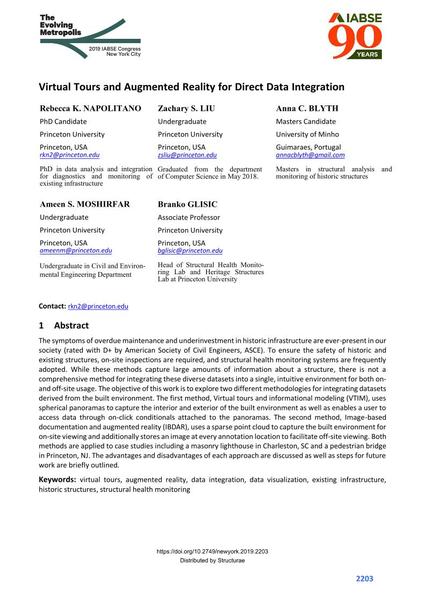Virtual Tours and Augmented Reality for Direct Data Integration

|
|
|||||||||||
Bibliografische Angaben
| Autor(en): |
Rebecca K. Napolitano
(Princeton University)
Zachary S. Liu (Princeton University) Anna C. Blyth (Princeton University) Ameen S. Moshirfar (Princeton University) Branko Glisic (Princeton University) |
||||
|---|---|---|---|---|---|
| Medium: | Tagungsbeitrag | ||||
| Sprache(n): | Englisch | ||||
| Tagung: | IABSE Congress: The Evolving Metropolis, New York, NY, USA, 4-6 September 2019 | ||||
| Veröffentlicht in: | The Evolving Metropolis | ||||
|
|||||
| Seite(n): | 2203-2212 | ||||
| Anzahl der Seiten (im PDF): | 10 | ||||
| DOI: | 10.2749/newyork.2019.2203 | ||||
| Abstrakt: |
The symptoms of overdue maintenance and underinvestment in historic infrastructure are ever-present in our society (rated with D+ by American Society of Civil Engineers, ASCE). To ensure the safety of historic and existing structures, on-site inspections are required, and structural health monitoring systems are frequently adopted. While these methods capture large amounts of information about a structure, there is not a comprehensive method for integrating these diverse datasets into a single, intuitive environment for both on- and off-site usage. The objective of this work is to explore two different methodologies for integrating datasets derived from the built environment. The first method, Virtual tours and informational modeling (VTIM), uses spherical panoramas to capture the interior and exterior of the built environment as well as enables a user to access data through on-click conditionals attached to the panoramas. The second method, Image-based documentation and augmented reality (IBDAR), uses a sparse point cloud to capture the built environment for on-site viewing and additionally stores an image at every annotation location to facilitate off-site viewing. Both methods are applied to case studies including a masonry lighthouse in Charleston, SC and a pedestrian bridge in Princeton, NJ. The advantages and disadvantages of each approach are discussed as well as steps for future work are briefly outlined. |
||||
| Stichwörter: |
historische Bauten
|
||||
